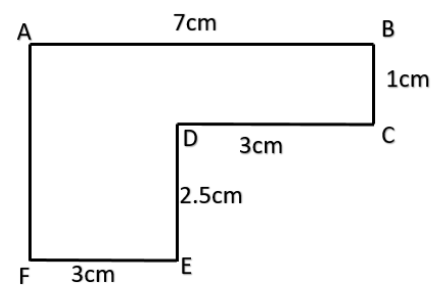
Find the perimeter of the given figure


Answer
570.6k+ views
Hint: To find the perimeter of the object we will add all the length of all sides of the given figure. If we do not have a particular side then we will find it with the help of the figure. Hence we will get the perimeter that is the length of the border of the figure.
Complete step-by-step solution:
Now let us see what does perimeter means.
The perimeter is defined on 2-D objects.
Now 2-D objects mean 2-dimensional objects.
A two-dimensional object is an object which has only two measures that is length and width and no thickness.
For example a square, a rectangle.
Now we also have something called 3-D objects.
Objects that we see around us are 3-dimensional objects.
It has length, width as well as thickness.
Now let us see some examples of 3-dimensional objects
cube, sphere, cuboid, pyramid, etc.
Now the perimeter is defined only for 2 Dimensional objects.
Perimeter means the length around the objects. Hence perimeter is nothing but the measure of the border of an object.
For example, let us consider a triangle with each side 5 cm

Now here the perimeter of triangle will be the length of the border
Hence perimeter $= 5 + 5 + 5= 15cm$
Hence perimeter of the square is 15 cm.
Now consider the given figure.

Now we know that perimeter of this figure is $AB + BC + CD + DE + EF + FA.$
From the figure we have $AB = 7, BC = 1, CD = 3, DE = 2.5, EF = 3.$
Now from the figure, we can say that $AF = DE + BC$
Hence $AF = 2.5 + 1 = 3.5.$
Now again consider the perimeter $AB + BC + CD + DE + EF + FA.$
Substituting the values we get perimeter as
$= 7 + 1 + 3 + 2.5 + 3 + 3.5$
$= 14 + 2.5 + 3.5 $
$= 14 + 6 $
$= 20cm$
Hence the perimeter of the given figure is 20cm.
Note: Now note that the difference between area and perimeter. Perimeter is the total length of the border while the area is a total measure of the object. Now both quantities are measures of 2-dimensional objects. The unit for Area is \[c{{m}^{2}}\] or ${{m}^{2}}$ while the unit of perimeter is cm or m.
Complete step-by-step solution:
Now let us see what does perimeter means.
The perimeter is defined on 2-D objects.
Now 2-D objects mean 2-dimensional objects.
A two-dimensional object is an object which has only two measures that is length and width and no thickness.
For example a square, a rectangle.
Now we also have something called 3-D objects.
Objects that we see around us are 3-dimensional objects.
It has length, width as well as thickness.
Now let us see some examples of 3-dimensional objects
cube, sphere, cuboid, pyramid, etc.
Now the perimeter is defined only for 2 Dimensional objects.
Perimeter means the length around the objects. Hence perimeter is nothing but the measure of the border of an object.
For example, let us consider a triangle with each side 5 cm

Now here the perimeter of triangle will be the length of the border
Hence perimeter $= 5 + 5 + 5= 15cm$
Hence perimeter of the square is 15 cm.
Now consider the given figure.

Now we know that perimeter of this figure is $AB + BC + CD + DE + EF + FA.$
From the figure we have $AB = 7, BC = 1, CD = 3, DE = 2.5, EF = 3.$
Now from the figure, we can say that $AF = DE + BC$
Hence $AF = 2.5 + 1 = 3.5.$
Now again consider the perimeter $AB + BC + CD + DE + EF + FA.$
Substituting the values we get perimeter as
$= 7 + 1 + 3 + 2.5 + 3 + 3.5$
$= 14 + 2.5 + 3.5 $
$= 14 + 6 $
$= 20cm$
Hence the perimeter of the given figure is 20cm.
Note: Now note that the difference between area and perimeter. Perimeter is the total length of the border while the area is a total measure of the object. Now both quantities are measures of 2-dimensional objects. The unit for Area is \[c{{m}^{2}}\] or ${{m}^{2}}$ while the unit of perimeter is cm or m.
Recently Updated Pages
You are awaiting your class 10th results Meanwhile class 7 english CBSE

Master Class 10 General Knowledge: Engaging Questions & Answers for Success

Master Class 10 Science: Engaging Questions & Answers for Success

Master Class 10 Social Science: Engaging Questions & Answers for Success

Master Class 10 Maths: Engaging Questions & Answers for Success

Master Class 10 English: Engaging Questions & Answers for Success

Trending doubts
Convert 200 Million dollars in rupees class 7 maths CBSE

i What trees does Mr Wonka mention Which tree does class 7 english CBSE

What are the controls affecting the climate of Ind class 7 social science CBSE

What was the main occupation of early Aryans of rig class 7 social science CBSE

Write a letter to the editor of the national daily class 7 english CBSE

Welcome speech for Christmas day celebration class 7 english CBSE





